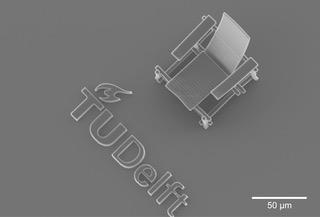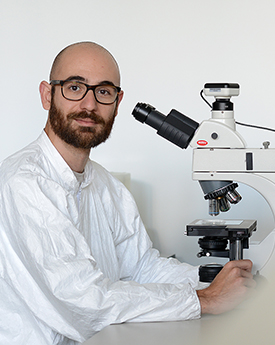Making precise structures at the smallest scale
Attractive tools for biomedical and pharmaceutical research
Imagine a tiny sensor setting off an alarm when a healing wound gets infected, or the effects of an experimental drug being tested not on a human or animal, but using a tiny chip packed with biological cells and sensors. The biomedical field is more and more turning to technology at the smallest scales. Dr. Luigi Sasso, at the Department of Precision and Microsystems Engineering (PME) works to enable the large-scale fabrication of such small-scale technologies. The latest addition to the set of tools at his disposal is an advanced 3D printer (called the Nanoscribe) that routinely produces structures as small as 20 millionth of a millimeter. “We’re very happy that we can now cover the full resolution range,” Sasso says.
Organ-on-chip
An exciting avenue being pursued in the area of personalized medicine is to test treatment options for each individual patient using only a small amount of cells or tissue. How do you channel nutrients or drugs towards these cells and achieve a real-time read out of how they respond to these drugs? Sasso uses soft plastics, called polymers, to build tiny structures incorporating, on the one hand, channels for the transport of liquids and, on the other hand, sensors. “Polymers are biocompatible: cells like them better than other materials. They can also be made to conduct electricity, which allows them to be crafted into electrochemical sensors.” These sensors are sensitive to biomedical parameters such as the local acidity (pH), temperature or glucose levels. As Sasso explains, “The blood’s glucose level, for example, provides information about a cell’s metabolism, while changes in the pH of a wound that’s in the process of healing can indicate an infection taking place.” When such sensors are embedded in structures designed to hold cells and channel liquids, miniature laboratories are obtained (an approach called ‘organ-on-chip’) that are very attractive tools for biomedical and pharmaceutical research.
Replicating
With the basic concepts proven in laboratory conditions, for Sasso and his team, the challenge lies in ways to precisely and reliably replicate the systems, paving the way for large-scale production and use. Their main technique to replicate polymer-based structures is that of soft embossing. In this approach, a mold is created and used to ‘stamp’ the desired structures into soft polymer material. The length scales of these structures vary from the micro (1 micrometer = 1 thousandth of a millimeter) to the nanoscale (1 nanometer = 1 millionth of a millimeter). “The smaller and more precisely the structure can be made and, most importantly, replicated, the better,” explains Sasso.
Drug development
Take, for example, research on drugs that help prevent kidney stones. Kidney stones are due to substances found in urine that initially form crystals and eventually macroscopic stones. . In order to speed up drug testing, biomedical researchers are looking for tiny test substrates that can host the basic material making up these crystals, and that allow the drug under study to be introduced and its effect on the crystal growth monitored. It has been found that the growth of the kidney stone crystals on polymer substrates can be controlled by carefully designing the surface structure: the more the surface mimics the crystal structure of the kidney stone material, the faster the material grows and the quicker it can be used to evaluate new drugs. Sasso’s approach to mass-produce finely structured polymer substrates can therefore help speed up drug development.
3D printing on the nanoscale
Attaining the highest resolution is key to Sasso’s work, which is why his latest tool, nicknamed the ‘Nanoscribe’ after the company that supplied it, is such a big deal. “We now have access to all relevant length scales, from 20 nanometer to the millimeter scale.” To print 3D structures on these small scales, the Nanoscribe uses a technique inspired by conventional chip fabrication. During the chip fabrication step called lithography, a thin polymer layer is partly illuminated with UV light. The illumination affects the local chemical structure of the layer, so that, in a next step, the non-illuminated areas can be dissolved and removed, leaving only the parts that were originally illuminated. Instead of UV light, the Nanoscribe uses a 2-photon absorption process to illuminate the polymer layer, one 3D pixel of 20 nm in size at a time. “We are very excited to welcome the Nanoscribe. It opens new avenues for our group. Well before it arrived, my students were already planning one project after another.”
The smallest Rietveld chair in the world
The Nanoscribe will undergo a series of tests to verify its ability to produce nanoscale features as small as 20 nanometer. As a first exercise in operating the machine, Sasso programmed it to 3D-print a Rietveld chair of 100 micrometer (one tenth of a millimeter) in size. “Although huge in terms of what the Nanoscribe can do, we thought it was fun to start simple. The result is beautiful.” The new machine could reproduce the entire Madurodam miniature park in just a few square centimeters.

Diversity
In the development chain stretching from idea to product, Sasso focuses on enabling technologies, developing the methods and techniques that will be vital to fabricating future products on a larger scale, most notably tools for biomedical research. In other words, he brings exploratory laboratory concepts to users worldwide. Sasso comments: “Delft is a very fruitful place for this type of research. There is a very good collaborative spirit in the Department of Precision and Microsystems Engineering. Our researchers cover all relevant disciplines, from theoretical modeling to experimental approaches. This diversity allows us to look at challenges from different angles. Our engineering mentality makes us an attractive partner to complement biomedical experts.”
Next frontier
In his quest to find solutions to reproducibly structure materials and to increase the functionality of these structures, Sasso’s next frontier is that of composite materials, where non-polymeric materials, such as nanoparticles, are added to the mix, introducing new functionalities to the system but also new challenges to the production and replication process. “These are challenges we’re ready to take on,” concludes Sasso.
NERI
The department PME initiated the NanoEngineering research Initiative (NERI). NERI is a platform for long-term collaboration of industry and academia to jointly turn nanoscience into industrially relevant applications: Moving nano from lab to app.
Moving nano from lab to app requires a new knowledge and technology foundation that allows the development and engineering of repeatable and reliable relevant functions and applications at an industrially relevant scale. This challenge requires cooperative efforts from both industry and academia.
Luigi Sasso
